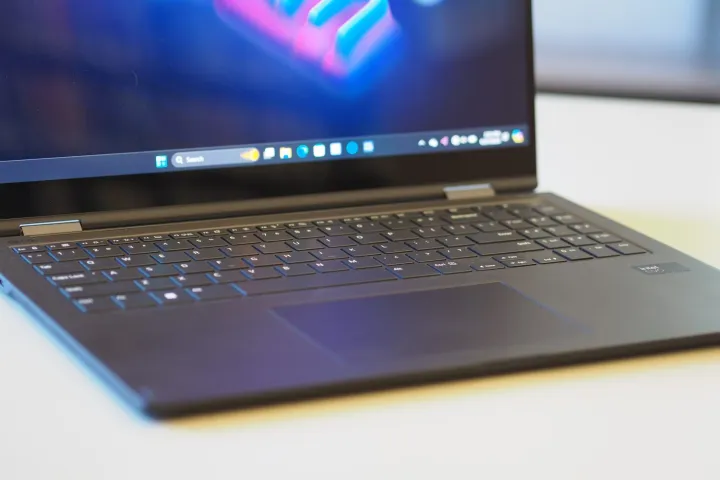With all the talk about Microsoft Copilot+ and Windows on Arm, it’s easy to forget that most laptops these days are still powered by Intel’s Meteor Lake chipset. These are viable laptops, especially if you want a device that doesn’t have Qualcomm’s Snapdragon X Elite. The LG Gram 16 2-in-1 is one such laptop, with a large display in a very portable package.
And when I say “portable,” I mean it. The LG Gram 16 2-in-1 is incredibly thin and light, with a beautiful 16-inch high-resolution OLED display. It’s designed for people who want a lot of screen real estate but don’t want to carry around a thick, heavy laptop. In this respect, the LG Gram 16 2-in-1 delivers, but it has some important flaws to consider before buying.
LG offers two configurations of the Gram 16 2-in-1. The first costs $1,500 and includes an Intel Core Ultra 7 155H chipset, 16GB of RAM, a 1TB SSD, and a 16.0-inch 3K OLED display. For an additional $600, you can upgrade to 32GB of RAM and a 2TB SSD.

These are premium prices, and you’ll probably pay a bit more for the very thin and light design. The Gram 16 2-in-1’s most logical competitor, the HP Spectre x360 16, is much thicker and faster, and starts at $1,600 for the same chipset and RAM, but with a 512GB SSD and a 16,0-inch IPS display. You’ll pay $1,815 ($1,315 on sale) for the exact same configuration.
The higher-end Spectre costs $2,335 ($1,835 on sale) and has a faster Nvidia GeForce RTX 4050 GPU. So if you can find a sale on the HP, you could pay a few hundred dollars less, depending on the configuration, and get a faster laptop. While not a 2-in-1, the MacBook Air 15 is a good comparison, and it’s similarly priced.
LG’s Gram series aims to be incredibly thin and light, and the Gram 16 2-in-1 meets these requirements. It has a stunning 16-inch OLED touchscreen, yet it’s just 0.51 inches thick at its thickest point and 0.49 inches at its thinnest. It weighs 3.08 pounds, which is lighter than some 14-inch laptops. For comparison, the HP Spectre x360 16 is 0.78 inches thick and weighs 4.3 pounds, making it much less comfortable to use in tablet mode. The clamshell model of the MacBook Air 15 is just 0.45 inches thick and weighs 3.3 pounds, making it feel more substantial in your hand.
Speaking of feel, the Gram 16 2-in-1 is made from magnesium, a lightweight alloy that’s stable yet flexible. Compared to the all-aluminum designs of the Spectre and MacBook Air, you’ll find the chassis, keyboard surface, and lid to be much more flexible. That’s not to say it’s a poorly constructed notebook; it’s not the best choice for those who prefer a stiff notebook.

The Gram 16 2-in-1 is aesthetically pleasing, with an all-black color scheme and subtle contouring around the edges to keep it from standing out. The MacBook Air 15 has a more substantial look thanks to Apple’s meticulous design, while the Spectre x360 15 is a bit more flashy. None of these laptops stand out enough that aesthetics are the deciding factor.
The keyboard is very similar to Apple’s Magic Keyboard, with well-spaced keys, large key caps, and very flat keys. I found the switches to be quick and accurate. Unless you hate flat keyboards, you’ll love this keyboard. The Spectre x360 16’s keyboard has a wider range of motion, which some may prefer to the Gram 16 2-in-1. The
touchpad is disappointing. First, it’s too small; there’s room for a much larger version. Second, it’s mechanical, and more premium laptops are now offering tactile touchpads that are more precise, quieter, and offer additional functionality. Both the MacBook Air 15 and Spectre x360 16 have much better touchpads.
Connectivity is good for a very thin and light laptop with a mix of modern and traditional ports. The only thing missing is an SD card reader, which creative types won’t like. Given the beautiful display, you can imagine this being a good laptop for appreciating photos and videos, even if it’s not the fastest when it comes to processing. Wireless connectivity is a generation behind, but it won’t be outdated for a while. The
webcam runs at 1080p, the same as the MacBook Air, but much better than the 9MP webcam on the Spectre. Image quality is good enough, and it supports Microsoft’s Studio Effects software via the Intel Meteor Lake Neural Processing Unit. It can’t match the Microsoft Copilot+ PC in this regard, though. Despite being an “AI PC,” the device doesn’t have many AI features to speak of. The infrared camera is good for Windows 11 Hello facial recognition.

Most 16-inch laptops are aimed at creative professionals, so they have more powerful components than the LG Gram 16 2-in-1. The 28-watt Intel Core Ultra 7 155H chipset with 16 cores (six performance-efficient and two power-efficient) and 22 threads is fast enough for CPU-intensive tasks, but the integrated Intel Arc graphics isn’t fast enough to speed up tasks like video encoding.
For this you need a dedicated graphics card, which the Spectre x360 16 offers, but the entry-level RTX 4050 is the way to go. The MacBook Air 15 uses Apple’s M3 chipset, which is about as fast as the Core Ultra 7 155H, but with optimizations that speed up creative tasks.
Ultimately, the Gram 16 2-in-1 is fast enough for users who need a larger display for productive multitasking workflows, or for media consumers who prefer a larger OLED panel. Creative people might not like this, but it probably doesn’t apply to a laptop that’s so thin and light.
LG’s Gram laptops typically have good battery life, but I was skeptical because the battery capacity is only 77 watt-hours, which isn’t much for a 16-inch laptop, and the power-hungry, high-resolution OLED display uses a lot of power. I wasn’t expecting much.

However, it lasted 9.5 hours in our web browsing test and 12.25 hours in our video loop test. These are good results for an Intel Meteor Lake laptop, and enough to last nearly a full day when performing general productivity tasks. Some other 16-inch laptops have much worse battery life, even with much larger batteries. So I consider this a win for the Gram 16 2-in-1.
Besides its incredibly thin and light body, the Gram 16 2-in-1’s best feature is its big 16-inch display. It’s plenty sharp at 3K (2880 x 1800), but it runs at a fast 120Hz, delivering bright colors and deep blacks right out of the box.
My colorimeter agreed: the OLED panel is brighter than most OLEDs I’ve tested, hitting 489 nits (well above the baseline 300 nits). Its contrast is nearly infinite, an astounding 27,810:1. This kind of brightness and contrast combination makes for impressive HDR. Color coverage is also broad, with 100% sRGB, 96% AdobeRGB, and 100% DCI-P3, and color accuracy was also good with a Delta-E of 0.85. It doesn’t get much better.

Overall, this display is sure to please anyone. It’s big and beautiful, and perfect for productivity, creativity, and media consumption.
The Gram 16 2-in-1 does have its weaknesses: it’s a little flexible, which may bother some, and it doesn’t offer the kind of graphics performance that many people considering a 16-inch laptop need for demanding creative workflows.
But it’s plenty fast for the dedicated productivity user, and it’s incredibly thin and light, making it easy to carry around, and the large display is great for both working and watching high-quality content. It’s a little pricey, but we can easily recommend it.
